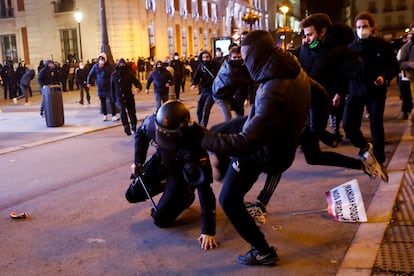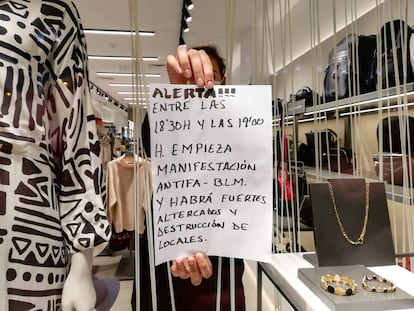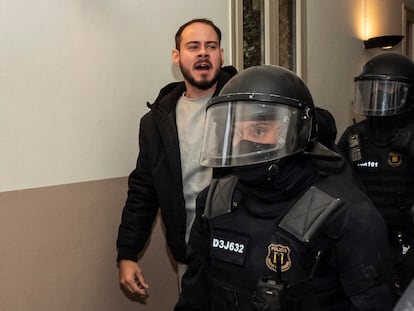Violent protests erupt in Madrid and Catalonia over rapper’s arrest
Supporters of Pablo Hasél, who is serving a nine-month sentence for praising terrorism and insulting the monarchy, clashed with riot police and framed their acts as a defense of freedom of speech
Street protests that began in Barcelona over the arrest of Spanish rapper Pablo Hasél extended to Madrid on Wednesday night, leading to clashes between supporters of the musician and riot police.
Around 100 officers confronted hundreds of people, mostly youths, who had congregated in downtown Madrid to demand the release of the singer, who was recently convicted of praising terrorism and insulting the Crown in messages on social media. His case has reignited a debate over the limits of freedom of speech in Spain.

A court had refused to suspend Hasél’s nine-month sentence due to his criminal record, which included convictions for assault and for writing songs that expressed admiration for terrorist acts. Catalan police arrested him on Tuesday after he refused to report to prison in Lleida.
The arrest first triggered street protests in Catalonia, where a young woman lost an eye in clashes with riot police. In Barcelona, demonstrators erected barricades and set street furniture on fire on Wednesday, leading to 29 arrests according to the regional police force, the Mossos d’Esquadra. In Madrid, at least 14 people were arrested in clashes with the National Police.
Political fallout
The events have already had political repercussions. On Thursday morning, Deputy Prime Minister Carmen Calvo of the Socialist Party (PSOE) criticized Pablo Echenique, the parliamentary spokesperson for the leftist Unidas Podemos, for defending the violent protests. Unidas Podemos is the PSOE’s partner in Spain’s governing coalition.
“It is one thing to defend that a democracy must be rigorous about freedom of expression, and another to encourage situations where we have seen injuries and arrests,” said Calvo in an interview on the Cadena Ser radio network, alluding to a Twitter message in which Echenique defended “young anti-fascists who are asking for freedom of expression on the streets.”
Madrid regional premier Isabel Díaz Ayuso and the mayor of the Spanish capital José Luis Martínez-Almeida, both of the Popular Party (PP), on Thursday asked the government to dismiss Deputy PM Pablo Iglesias of Unidas Podemos, accusing him of being behind the acts of vandalism.
Code 33 in Vic
In the Catalan capital, Mossos reported that protesters hurled stones, bottles and blunt objects in Urquinona square, Via Laietana and Ronda de Sant Pere. Local storefronts were spray painted and patrol cars hit with “incendiary devices.” Officers were pelted with stones to the cry of: “Out with the occupation forces.”
Elsewhere in Catalonia, around 300 youths set trash bins on fire in Girona, while in Lleida protesters burnt containers near Ponent penitentiary, where Hasél is being held. There were also protests in Girona and Vic, where Catalan authorities talked about “extreme violence.”
In Vic, protesters destroyed a Mossos police precinct, shattering glass, cutting the phone lines, taking out security cameras and damaging a van. Officers were forced to ask for reinforcements using Code 33, which denotes “an extremely serious situation,” said the Catalan chief of internal affairs, Miquel Sàmper. Vic Mayor Anna Erra condemned the violence and said that “a red line has been crossed, [protests] had never ended with such disturbances.”
Clashes in Madrid

In Madrid, riot officers used batons against the protesters, who physically engaged with the police. There were early clashes in Puerta del Sol square until officers pushed the protesters into Arenal, one of the streets that open into the popular landmark. A branch office of Caixabank on Calle Mayor was burnt down, and storefront windows smashed on the same street. Protesters carried signs with slogans such as “Pablo Hasél, Freedom, Out with Francoist Justice.”
Jorge Gómez, a 24-year-old protester in Madrid, said that the laws that got Hasél convicted are “worthy of the Middle Ages.”
“There is a lack of freedom of expression, because Hasél only said obvious things,” he added.
Julia Castro, 22, argued that “many reggaeton songs contain messages that are degrading to women, and millions of people listen to them, while only a minority listens to Hasél.”
A few protesters attempted to break the window of a clothing store in Puerta del Sol. Inside, two employees huddled in fear. Isabel Espinosa showed a piece of paper that an unknown person had handed her at 6pm, warning about “big disturbances and destruction of businesses.” Her colleague Andrea Pascual said she was “terrified.” The square was cleared shortly before 9pm and the police began carding around 100 protesters.
Woman loses eye
A young woman who participated in Barcelona protests on Tuesday has lost an eye, the regional health department confirmed on Wednesday. The 19-year-old has already undergone surgery once and will go through another procedure on Thursday at Clínic Hospital.
A human rights group called Irídia said on Wednesday that the injury was caused by a foam-tipped projectile of the kind used by the Mossos d’Esquadra. Health authorities said a forensic expert will determine what caused the young woman’s eye to burst.
Irídia is asking citizens for help finding images and witness testimony to prove that it was a riot police projectile that caused the injury. “There are clear indications that it was an impact from a foam [projectile]; this type of injury is clearly compatible with these kinds of projectiles, but a judge and a forensic scientist will have to analyze it,” said Andrés García, a lawyer and co-director of the human rights group.
Irídia has been demanding a review of internal control mechanisms on the use of these weapons by the Catalan police. “It’s a precision weapon. The bullets do not require rebound, like the rubber rounds used to, and so their trajectory can be controlled. They should never reach the head area,” said García.
His group would like the Catalan parliament to create a committee to address the debate over these weapons, which have been used by the Mossos for nearly a decade.
English version by Susana Urra.
Tu suscripción se está usando en otro dispositivo
¿Quieres añadir otro usuario a tu suscripción?
Si continúas leyendo en este dispositivo, no se podrá leer en el otro.
FlechaTu suscripción se está usando en otro dispositivo y solo puedes acceder a EL PAÍS desde un dispositivo a la vez.
Si quieres compartir tu cuenta, cambia tu suscripción a la modalidad Premium, así podrás añadir otro usuario. Cada uno accederá con su propia cuenta de email, lo que os permitirá personalizar vuestra experiencia en EL PAÍS.
¿Tienes una suscripción de empresa? Accede aquí para contratar más cuentas.
En el caso de no saber quién está usando tu cuenta, te recomendamos cambiar tu contraseña aquí.
Si decides continuar compartiendo tu cuenta, este mensaje se mostrará en tu dispositivo y en el de la otra persona que está usando tu cuenta de forma indefinida, afectando a tu experiencia de lectura. Puedes consultar aquí los términos y condiciones de la suscripción digital.
More information
Últimas noticias
Imelda Castro, the woman who wants to rule the cartel battleground of Sinaloa
The new victims of the Republican war on Obamacare: Millions hit by soaring health insurance premiums
A country divided on migrant rights: Some US states expand protections while others restrict them
Venezuela authorizes the release of another 87 political prisoners
Most viewed
- David King, chemist: ‘There are scientists studying how to cool the planet; nobody should stop these experiments from happening’
- Reinhard Genzel, Nobel laureate in physics: ‘One-minute videos will never give you the truth’
- Oona Chaplin: ‘I told James Cameron that I was living in a treehouse and starting a permaculture project with a friend’
- Sinaloa Cartel war is taking its toll on Los Chapitos
- The Interoceanic Train, the Mexican alternative to the Panama Canal











































